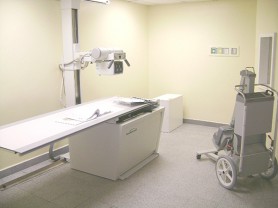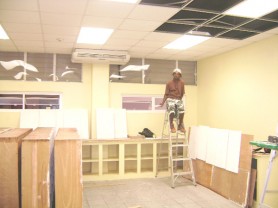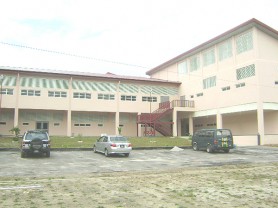– to be operational by August 1, though staffing still a problem
By Cathy Richards
Several sections of the new $1.8 billion Linden Hospital Complex (LHC) were officially handed over to its management on Thursday last and the administration remains confident that it will be fully operational by August 1.

The areas handed over include the male and female wards, rehabilitation rooms, the pharmacy and the laboratory.
The building of the new hospital was funded by the Inter-American Development Bank.
At a brief ceremony to mark the occasion on Thursday, Minister of Health Dr Leslie Ramsammy said he was pleased with the work done by the contracting firm R Bassoo and Sons. “From designing to construction… I am expecting that all the services that deal with out-patients, accident and emergency, the laboratory, radiology to pharmacy would be operationalized this month,” Ramsammy said. He also said the operating theatres would have to be sterilized therefore they would be among the last units to be made functional.
Meanwhile, the hospital’s management expects to start operations on August 1, while the hospital will be officially commissioned in September.
Over the weekend, several departments began to be moved to the new facility though

services will still be provided at the old building until the commissioning.
The administrative section of the Linden hospital will still be located in the old building, since according to CEO Gordon Gumbs, the new structure was not designed with accommodation for the administrative staff, or with areas for the Prevention of Mother to Child Transmission (PMTCT) counselling and testing unit.
In a recent interview, Gumbs said over the past weeks staff had been trained to use several new components including the new boiler system, the nurse call units, air conditioning and medical gas units. He also said though several new pieces of equipment had arrived they have not been installed in some sections of the hospital.
This newspaper toured the new facility last week and observed workers adding the finishing touches to several electrical units and erecting shelves and cupboards in the laboratories and pharmacy areas. Various pieces of equipment were also being installed in the two operating theatres and one of the two x-ray departments and the boiler system and air conditioning units were being tested. The male, female and paediatric wards, each of which will cater for infectious and non-infectious patients, were completed though the rooms had not been furnished neither had equipment been installed in the laboratories and delivery rooms. The elevator was not in operation. The two-storey building houses an out-patient area as well as a pharmacy, emergency and x-ray departments in the lower flat. The top flat was designed strictly for patient care.

Gumbs said he hoped that by the time the hospital is fully operational more doctors would be available to treat patients.
He said that currently the hospital has seven doctors and two medics on staff. There is also a part-time orthopaedic doctor and dermatologists from Georgetown visit once a month. A ‘family doctor’ is stationed at the Upper Demerara Hospital and another one at Kwakwani; both hospitals are managed by the LHC.
The CEO said though he believes the team of doctors and medics can sufficiently meet the majority needs of the hospital, the ongoing exodus of the Chinese and Cuban doctors poses a number of challenges.
He told Stabroek News that it takes some time for the non-national doctors to become familiar with the language, culture, practices and norms of locals and by the time they are acclimatised their service period comes to an end and the cycle is repeated.
He also acknowledged that the administration is challenged by doctors who are habitually late. Gumbs said in the past the administration had dealt with defaulting doctors by not renewing their contracts and it would continue with this action. “It is a very difficult situation to have to discontinue the service of a doctor when we are operating with a shortage but we have been in constant dialogue to ensure that they comply with the system,” he said. He also said patient concerns are addressed; several persons complained of the long wait experienced at the hospital for special clinics.
According to Gumbs, the hospital has also experienced a frequent exodus of nurses which has left it “brain-drained”. He said: “Nurses have been leaving in large numbers for the UK and other countries for better monetary rewards. However, this activity has reduced considerably over the past few years and so we are doing our best to make our nurses comfortable so they can stay and serve.”
This newspaper understands that while the hospital currently has a complement of some 230 staff, another 30-40 would be required to fulfil the demands at the new facility.
At the same time, the CEO is confident that when the hospital becomes fully functional, service to Region Ten would improve tremendously.
The hospital’s large veranda provides a charming view of the Demerara River and surrounding communities which can be enjoyed by both in and out patients. The compound is also beautifully landscaped and is enhanced by a garden of mainly permanent crops such as pigeon peas, bora, pumpkin, plantain and banana suckers line the LHC’s chain-linked fence.





